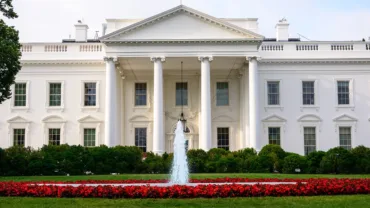In the Back to the Future film trilogy, a DMC-12 automobile (or more commonly known as a DeLorean) is converted into and used as a time machine throughout the three movies.
The DMC-12 was the only model of automobile produced by the DeLorean Motor Company, named for its founder, auto engineer John DeLorean.
Unfortunately for the car creator, his namesake car did not sell well when it was originally produced, from January 1981 until the Belfast, Northern Ireland, plant’s closure in December 1982. This led to severe economic troubles for the company.
DeLorean needed $17 million to save his company from collapse. To this end, he spent much of 1982 desperately seeking investors for his failing company.
He was approached by one such investor named James Hoffman on June 28, 1982, who claimed to have a business opportunity to help save DeLorean’s company.
Unknown to DeLorean, James Hoffman was actually a convicted drug smuggler, who, in exchange for leniency, struck a deal with federal authorities to become an informant.
Because of DeLorean’s busy schedule in meeting with numerous investors, it took quite a bit of effort on Hoffman’s part to secure an in-person, one-on-one meeting with DeLorean; he finally succeeded on July 11.
Hoffman offered to connect DeLorean with potential investors who could provide $15 million of immediate capital, but only if Hoffman were to act as a middle-man and would receive a 10% commission of $1.5 million in addition to $300,000 for “expenses.”
After numerous phone conversations with other federal agents posing as players in the purported “investment deal,” DeLorean began to get suspicious, particularly after a September 1982 meeting with Hoffman in which Hoffman talked at length about “Colombian investors” who would supply $30 million in exchange for a $1.8 million investment from DeLorean.
At this point, DeLorean became suspicious that he had become involved in a dangerous and illegal operation, possibly involving illegal narcotics or organized crime (or both). He felt that he needed to remove himself from the situation as soon as possible.
DeLorean contacted DMC corporate attorney Tom Kimmerly and explained the situation. Kimmerly advised DeLorean to stall Hoffman as best he could.
However, in the face of a thinly-veiled threat by Hoffman that DeLorean’s daughter would be murdered if he backed out of the deal, DeLorean continued to communicate with Hoffman.
On October 19, DeLorean was to meet with Hoffman in Los Angeles. Before leaving, however, he handwrote a detailed letter to his attorney in New York describing what he called an elaborate “play-acting scenario” that DeLorean correctly believed involved using Eureka Federal Savings and Loan as a front for laundering money. DeLorean named all individuals known to him to be participants in the conspiracy.
The letter was hand-delivered to his attorney with instructions to open it only if he did not return.
That same day, DeLorean flew to Los Angeles to meet with Hoffman and another undercover federal agent, who met him at the airport before driving him to a hotel room.
DeLorean pretended to have the funds necessary for the transaction, which he came to believe was meant to be used to procure cocaine from Columbia for sale in the U.S., by speaking of a fake shell company from which he was going to issue stock to Hoffman to cover the funding (the promissory note issued by DeLorean was worthless because the company didn’t exist).
While in the hotel room, the agent accompanying Hoffman brought out a suitcase from a hotel closet and opened it on a table in front of DeLorean, stating that it contained cocaine. DeLorean continued to play along, discussing his company’s dire financial circumstances.
Eventually, another FBI agent entered the room, introduced himself to DeLorean as such, and proceeded to inform DeLorean that he was under arrest for “narcotics law violation.”
DeLorean’s trial began on April 19, 1984, and the case presented by DeLorean’s defense was damning to the prosecution.
Not only did they successfully portray DeLorean as being unwittingly drawn into the conspiracy, they also produced evidence and testimony demonstrating some gross misconduct by federal authorities.
Among this evidence was an unexplained 47-minute gap of audiotape (all of DeLorean’s meetings and phone conversations with the agents were recorded) during which DeLorean claimed he unequivocally told Hoffman that he was unwilling to become involved in criminal activity.
In addition, one of the defense’s witnesses was Gerald Scotti, a former DEA agent, who testified that Hoffman, after reading a Wall Street Journal article about DeLorean’s worsening financial problems, bragged to Scotti, “You know I’m going to get John DeLorean for you guys.” Scotti further testified that Hoffman bragged that he was going to get DeLorean by luring him with a way out of his financial troubles.
The defense’s cross-examination of Benedict Tisa, the agent accompanying Hoffman at the time of DeLorean’s arrest, revealed that he was aware that DeLorean did not want to participate in a drug deal. Further, Tisa admitted to destroying his notes from the investigation — tantamount to destruction of evidence.
To make things worse for the prosecution, Tisa was berated by a DOJ higher-up about his testimony, unaware that the conversation was being caught by open microphones leading to an adjacent press room outside of the courtroom — filled with reporters.
Finally, testimony by Hoffman, who had been intended to be the prosecution’s star witness, turned out to be extremely damaging to the government’s case in that he routinely lied just to land a “big fish” conviction like DeLorean.
On August 16, 1984, the jury returned their verdict in the case: not guilty, finding that DeLorean was a victim of clear government entrapment.
Unfortunately for DeLorean, his legal woes didn’t end there; he later faced criminal fraud charges (which he was also acquitted from at trial). He also faced civil investor lawsuits and a lawsuit for unpaid attorneys fees (of over $10 million).
John DeLorean died at the age of 80 on March 20, 2005, following complications from a stroke.
While DeLorean’s arrest was nothing short of bizarre, it serves as a good reminder that one should always be aware of the statutory definitions included in any criminal charge.
Luckily for DeLorean, though, the legacy he leaves behind isn’t his financial or legal problems. Rather, what the world will most remember about John DeLorean is his namesake car that traveled through time on the big screen.






